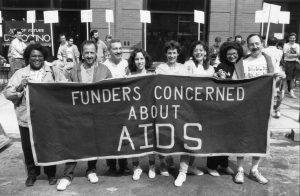Philanthropy’s Search for an HIV Vaccine: Building Public-Private Partnerships in a Global Pandemic
*This article originally appeared on RE:source, the Rockefeller Archive Center’s storytelling platform
A deadly new virus with no known cure spreads across the globe. Questions abound over who is most susceptible and whether countries should restrict travel and immigration. Public fear of the disease escalates.
Four decades before the outbreak of COVID-19, the world encountered a global pandemic similar to the one we’re experiencing in 2020: the Acquired Immunodeficiency Syndrome, or AIDS.
Discovered and named by the CDC in the early 1980s, AIDS had infected over 150,000 Americans by the end of the decade.
And yet, because the vast majority of the disease’s early victims were gay men, homophobia and prejudice meant that it took years of activism and advocacy to put AIDS onto the national agenda in the US. Members of the media and others referred to AIDS as “gay cancer,” spokesmen from the Reagan administration openly joked about the disease in the early 1980s, and it was not until 1987 — six years into his term — that the president delivered a public speech on AIDS. Despite important work by groups like ACT UP and the American Foundation for AIDS Research to raise awareness, federal inaction hampered the US response to the AIDS crisis, both at home and abroad.

Funders Concerned About AIDS Participating in an Advocacy Walk in New York City, c.1990.
As a result, it was clear that the spread of HIV, the virus that causes AIDS, required a massive and well-coordinated international response. By the early 1990s, an estimated 11 million people were infected with HIV, and the World Health Organization (WHO) believed this number would rise to at least 26 million by the year 2000, with roughly 90% of new cases occurring in the developing world.1 Today, more than 37 million people — including over 25 million in Africa alone — live with the virus and and these numbers are sure to grow. Despite years of research and experimentation, in 2020, scientists have yet to develop an HIV vaccine.
The philanthropic response to the epidemic began as early as 1981 with community foundations funding patient care. Several grantmaking foundations, including Robert Wood Johnson and Ford, joined the fight soon thereafter. More serious efforts continued in 1987 with the creation of Funders Concerned About AIDS, an umbrella organization of grantmakers that aimed to spark wider third sector interest in supporting HIV programs.
As the AIDS crisis escalated, however, both the public and private sectors were hesitant to fund vaccine work due to production uncertainties and the financial risks of investing in new and potentially ineffective medicine for the developing world. Therefore, most support went to HIV prevention education and health care programs that had thus far failed to slow the virus’s spread.
Read the full article here.
1. “Accelerating the Development of Preventive HIV Vaccines for the World: Summary Report and Recommendations of an International Meeting, March 7-11, 1994 in Bellagio, Italy,” June 1994, Rockefeller Foundation records, FA488, RG 1.27, Box R3380, AIDS Vaccine Initiative Conference, 1993-1994, RAC.